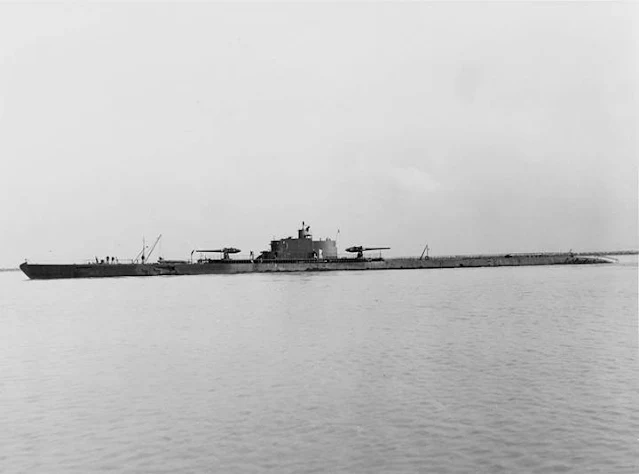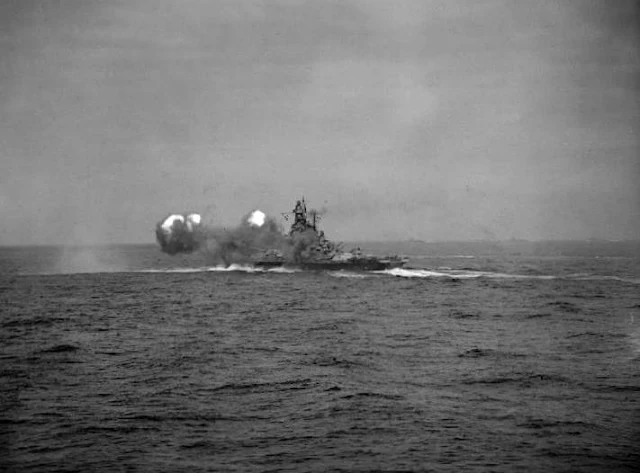 |
| Aichi E13 wreck on the beach at Palawan, Philippines, as LST 806 unloads, March 24, 1945. |
 |
| SS A. J. Cassatt on delivery from Bethlehem-Fairfield in August 1944. |
 |
| USS Alabama (BB-60) in Casco Bay, Maine, during her shakedown period, circa December 1942. Note her Measure 12 (modified) camouflage scheme. |
 |
| USS Alabama (BB-60), 1 December 1942, in camouflage. Note trunked tower foremast and funnel, similar to that used in the design of the later Iowa-class battleships. |
 |
| The U.S. Navy battleship USS Alabama (BB-60) under construction at the Norfolk Naval Shipyard, Virginia, circa 1941. |
 |
| Launching, at the Norfolk Navy Yard, Portsmouth, Virginia, 16 February 1942. |
 |
| In Casco Bay, Maine, during her shakedown period, circa December 1942. Note her Measure 12 (modified) camouflage scheme. |
 |
| USS Alabama during her shakedown period, Casco Bay, Maine, December 1942. |
 |
| Anchored in Casco Bay, Maine, circa December 1942. |
 |
| View looking aft from the bow, during a shakedown period high speed run, January 1943. Note telephone "talker" at edge of photo. |
 |
| View looking aft from the bow during a snowstorm. Taken during her shakedown cruise, circa January 1943. |
 |
| Fireman puts on a burner on one of the ship's boilers. Taken during her shakedown cruise, circa January 1943. |
 |
| Off the Norfolk Navy Yard, Portsmouth, Virginia, 7 February 1943, following post-shakedown availability and repainting. |
 |
| Escort carrier rolling in heavy weather. Note no one in the picture seems frightened. |
 |
| Kamikaze Oscar about to impact on the Savo Island (CVE-78) at about 5 p.m. on 5 January 1945. |
 |
| The flight deck of the carrier Ticonderoga burns after being struck by the one kamikaze (out of eight launched) that was not shot down by Navy gunners and fighters. East of Formosa, 21 January 1945. |
 |
| Surviving crew members of the Indianapolis are transported back to the United States aboard the escort carrier Hollandia. |
 |
| 20mm gun crew, Wisconsin, 1945. |
 |
| 5 March 1945 after Iowa's last wartime overhaul. She has just received the new enclosed bridge, some new electronics, and she now carries SC-1 Seahawk aircraft. |
 |
| Cover of the V-J Day Booklet issued for the Iowa (BB-61) on 2 September 1945. |
 |
| Iowa (BB-61) at Pier #91, Seattle, Washington. Photographed on 17 October 1945. Maryland (BB-46) is across the pier. |
 |
| Honolulu (CL-48), pre-war photo without radars. |
 |
| USS Laffey (DD 724), 8 August 1944, location unknown. |
 |
| U.S. Navy repair ship anchored at a Pacific island. |
 |
| Survivors of a landing craft sinking are rescued at Normandy, June 6, 1944. |
 |
| USS Wahoo (SS 238) off the Mare Island Navy Yard, California, July 14, 1943. |
 |
| The fleet submarine Tang, one of the most successful U.S. submarines. Tang was lost after being hit by one of her own torpedoes. |
 |
| American troops in British LCA landing craft seen near Weymouth in June 1944 while preparing for the landings in Normandy. |
 |
| The sole surviving Yorktown class vessel, Enterprise CV-6, decommissioned and headed for scrapping in 1958. |
 |
| Flight deck crew aboard the aircraft carrier USS Enterprise (CV-6) listening to instructions during the US Navy's Pacific Fleet maneuvers around Hawaii in 1940. |
 |
| Langley CVL-27 was an Independence-class light aircraft carrier named for the Navy’s first carrier which saw service across the Pacific during World War II. |
 |
| Pilots of F6F-3 Hellcats who shot down 21 Japanese enemy planes in less than 15 minutes over Truk Atoll, 29 April 1944, aboard USS Langley (CVL-27). |
 |
| Massachusetts somewhere at sea during World War II. |
 |
| Massachusetts resting at her last berth near Fall River, Massachusetts. Note her haze gray peacetime painting, large-sized pennant number, and SK-2 radar antenna on her tower mast. |
 |
| USS Oklahoma during scrapping at Pearl Harbor. |
 |
| This drawing shows the damage to the Oklahoma caused by the Japanese torpedoes. It also shows the Oklahoma capsizing, and how she came to rest. |
 |
| USS South Dakota underway sometime during World War II. |
 |
| USS Texas, view of Bofors and aft group of 356mm main caliber turrets. |
 |
| West Virginia BB-48 during scrapping. All that is left is the bottom of her hull. |
 |
| Seabees monument completed in 1974 in Arlington, Virginia. |
 |
| U.S. landing craft at beachhead on Guadalcanal. |
 |
| A quad 40-mm gun position in action on an American ship during a kamikaze attack. |
 |
| Aerial photo of Pearl Harbor Naval Shipyard taken 10 December 1941 showing the intact dry docks (center), repair shops (lower right) and a portion of the oil storage facilities (lower left). |
 |
| Huntington (CL-107), Dayton (CL-105) and South Dakota (listed from left to right). Laid up in reserve at the Philadelphia Naval Shipyard, Pennsylvania, 24 August 1961. |
 |
| USS Bass (SS-164), outboard, and USS Bonita (SS-165) with civilian visitors on board, at San Francisco, California, May 1932. |
 |
| USS Bonita (SS-165) underway, circa the middle 1930s. Note that her original 5"/51 deck gun has been replaced with a 3"/50. |
 |
| USS Argonaut SS-166. |
 |
| Lieut. Comdr. W.M. Quigley, who is in command of the V-4. Washington Navy Yard, 1928. Renamed the USS Argonaut. |
 |
| The V-4 (later USS Argonaut), Washington Navy Yard, 1928. |
 |
| V4 (SS-164), reclassified as minelaying type SM1 and renamed the Argonaut. November 1928. |
 |
| U.S. Navy submarine V5, renamed USS Narwhal SS-167, underway 20 January 1931. |
 |
| USS Narwhal SS-167 (V5) half-finished in Portsmouth Navy Yard, 1927. |
 |
| USS Narwhal (SS-167): View taken on the bridge while underway, 24 July 1930, shows ship's Commanding Officer, Lieutenant Commander John H. Brown, Jr., USN (center). |
 |
| The U.S. Navy submarine N2 USS Nautilus SS-168 underway in the early 1930s. |
 |
| Cutaway of USS Nautilus SS-168. |
 |
| USS Nautilus SS-168 off the Mare Island Navy Yard, California, 15 April 1942, following modernization. |
 |
| USS Nautilus SS-168 off Mare Island, 1 August 1943. |
 |
| USS Dolphin (SS-169) underway, circa 1932. |
 |
| USS Dolphin SS-169, at the Underwater Sound School, Hawaii, circa 1940. Note motor boat aft of the sail. |
 |
| USS Cachalot SS-170 leaving the Portsmouth Navy Yard, Kittery, Maine, for a 5000-mile endurance test, 7 March 1934. |
 |
| V2 (SS-166), renamed the Bass. 23 August 1935. |
 |
| USS Pike SS-173 underway off New London, Connecticut, while serving as a training submarine, 5 May 1944. |
 |
| USS Porpoise SS-172 off the Mare Island Navy Yard, 13 October 1942. |
 |
| USS Porpoise SS-172. 17 August 1936. |
 |
| USS Astoria CA-34 heavy cruiser heading for Pearl Harbor December 1941, during an operation to deliver carrier aircraft. The photo is taken from the heavy cruiser USS Portland CA-33. |
 |
| Heavy cruiser USS Astoria before upgrading in 1941. |
 |
| Heavy cruiser USS Astoria before upgrading in 1941. |
 |
| USS Indianapolis CA-35, a Portland class cruiser. |
 |
| USS Indianapolis CA-35 underway in 1939. |
 |
| U.S. destroyer in very stormy South China Seas in January 1945 alongside USS Taluga AO-62. |




























No comments:
Post a Comment